On tour at the Ozark Medieval Fortress guests often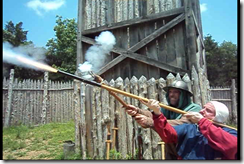 ask about gunpowder and Medieval guns and cannons. Gunpowder was invented by the Chinese during the Tang Dynasty, about the 900’s, but it was used just for fireworks and was not known in Europe. Black powder was separately invented in Europe by a German monk named Berthold Schwartz in 1315 and was quickly used to make primitive firearms. This, of course, is after the time frame of the Ozark Medieval Castle (1226-1246). The castle has, however, had the great opportunity to have demonstrations of Medieval guns as well as period weapons (swords, crossbows, etc.) by the Springfield, MO Bramble School of Defense on special occasions.
ask about gunpowder and Medieval guns and cannons. Gunpowder was invented by the Chinese during the Tang Dynasty, about the 900’s, but it was used just for fireworks and was not known in Europe. Black powder was separately invented in Europe by a German monk named Berthold Schwartz in 1315 and was quickly used to make primitive firearms. This, of course, is after the time frame of the Ozark Medieval Castle (1226-1246). The castle has, however, had the great opportunity to have demonstrations of Medieval guns as well as period weapons (swords, crossbows, etc.) by the Springfield, MO Bramble School of Defense on special occasions.
Medieval James Himself
Guide at Ozark Medieval Fortress
Sunday, May 29, 2011
Medieval Guns
Saturday, May 28, 2011
Medieval Sharpening Stone
The tour at the Ozark Medieval Fortress goes to the stone carvers’ hut. Although all the carved stones are a lot of work, one that has been especially impressive to me has been the sharpening stone. In 2010, the first season, the blacksmith began with a sharpening stone from France. By August he had asked the stone carvers to plan ahead and begin carving a new stone for sharpening tools. The old one had worn away and was doomed to become just a handheld stone rather than a rotating sharpening stone. 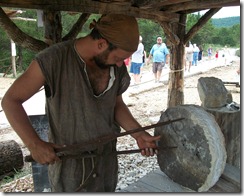
The stone carvers found a suitable stone. The carter transported it to the stone carvers’ hut and they went to work shaping the stone. It is thick. It is heavy. It had to be meticulously carved to be round. Finally, it had to have the center drilled through for the blacksmith to attach it to the trough and turning arm. The blacksmith customized new mounting brackets to balance the stone.
The cooperation between the skilled craftsmen and their interdependency is one of the authentic aspects of the Ozark Medieval Fortress.
Tuesday, May 24, 2011
Medieval Construction - The 13-Knot Rope
 “How did they measure on the job in the Middle Ages?” “What is the 13-Knot rope?” Guests at the Ozark Medieval Fortress have asked these questions and many have added the request to give some examples of how to use the 13-knot rope. The Middle Ages predates the use of the metric system in France. That was introduced after the French Revolution which is after the American Revolution. They used the standard system which now people in the U.S. think means “American”. It doesn’t. It means human system. The “inch” was the width of a man’s thumb. The “palm” was four fingers. The “hand” was the width of the flat hand including the thumb and is still used to measure the height of horses. People were smaller back then and the “hand” was four inches.
“How did they measure on the job in the Middle Ages?” “What is the 13-Knot rope?” Guests at the Ozark Medieval Fortress have asked these questions and many have added the request to give some examples of how to use the 13-knot rope. The Middle Ages predates the use of the metric system in France. That was introduced after the French Revolution which is after the American Revolution. They used the standard system which now people in the U.S. think means “American”. It doesn’t. It means human system. The “inch” was the width of a man’s thumb. The “palm” was four fingers. The “hand” was the width of the flat hand including the thumb and is still used to measure the height of horses. People were smaller back then and the “hand” was four inches.

Medieval women thought in terms of the span because their lives were so tied to making textiles and tunics. The benefit of the span is you can “walk” your hand in making measurements. Many elderly ladies on tour have said they remember their grandmothers measuring with the span. Incidentally later in the 1800’s with steam power at the mills and plentiful material ladies measured by the “yard”, from their nose to extended hand. Men more commonly measured by the two-span, or “foot”. That, of course, is 12 inches. Most U.S. men still see things by the foot, except for some teenagers who play football and see things by the yard. Three-span is a “cubit”, which was also considered the distance from a man’s elbow to fingertips. In the Bible, Noah used the cubit to measure the Ark.
It is likely that Noah did not just use his arm to measure the beams for the Ark, but also a rope. Use of a rope to measure goes way back. In the Egyptian pyramids, workers are pictured using a rope to measure with eleven knots, creating ten spaces. By the Middle Ages, we know they used a rope of 13 knots, creating twelve spaces and that the spacing was the “empan”. Basically, the reason for twelve spaces was that it was as high as the peasants and laborers could be expected to reliably count. There were no schools, but they were in Church each Sunday. In the Christian church, twelve is an important number. For example, there are twelve disciples.
The 13-knot rope in the Middle Ages was used as a tape measure, geometric compass and protractor. As a tape measure, a laborer could measure a stone, for example, to be two span, one hand and an inch. The opening of a door might be six span or a log might be cut at the full twelve span or even using the ropes of two men end-to-end for a full 24-span. The walls at the Ozark Medieval Fortress are 10-span wide.
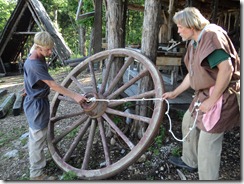 The 13-knot rope uses a loop as the first knot, which makes it easy to use as a geometric compass. The loop can by an eye-splice or a simple overhand knot. The curve of an arc, or even a full circle was easily made by using the end loop of the 13-knot rope as a center and selecting the appropriate knot for the radius. The builders knew the value of arches from the Romans and many were used in the Middle Ages. Remember also that a new technique took over the whole French theory of building in the 1100’s called the “ribbed vault”. That’s what they used on the cathedrals, which is a whole different story, but my point is that ropes were used for these, too. Circles, of course, were important for the round towers as well as the making of wheels at the carpenter and blacksmith shops.
The 13-knot rope uses a loop as the first knot, which makes it easy to use as a geometric compass. The loop can by an eye-splice or a simple overhand knot. The curve of an arc, or even a full circle was easily made by using the end loop of the 13-knot rope as a center and selecting the appropriate knot for the radius. The builders knew the value of arches from the Romans and many were used in the Middle Ages. Remember also that a new technique took over the whole French theory of building in the 1100’s called the “ribbed vault”. That’s what they used on the cathedrals, which is a whole different story, but my point is that ropes were used for these, too. Circles, of course, were important for the round towers as well as the making of wheels at the carpenter and blacksmith shops.
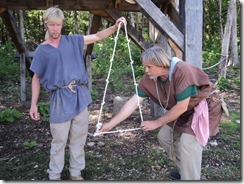 As a protractor, two workers would use the 13-knot rope to create geometric shapes. A steep (isosceles) triangle can be made with 5-5-2 spaces. Ship builders used this for the bows of the ships. Roofers used this for steeples. In general, it was known as a brace. That is a term that now makes people think of a medical brace. Old Western novels will say things like: “the outlaw held a brace of six-guns”, meaning two guns. The brace was what was used where today Americans might use a post. A brace takes longer to make, but the Medieval carpenters made things strong and a brace imitates the architecture of a man standing on two feet. They felt that design came from God and was worth imitating. The rope of one carpenter laid out the triangle. The rope of the second carpenter was laid up the middle of the triangle and they were able to mark the steep angles necessary for the cuts to make the two beams, or legs, meet perfectly at the top.
As a protractor, two workers would use the 13-knot rope to create geometric shapes. A steep (isosceles) triangle can be made with 5-5-2 spaces. Ship builders used this for the bows of the ships. Roofers used this for steeples. In general, it was known as a brace. That is a term that now makes people think of a medical brace. Old Western novels will say things like: “the outlaw held a brace of six-guns”, meaning two guns. The brace was what was used where today Americans might use a post. A brace takes longer to make, but the Medieval carpenters made things strong and a brace imitates the architecture of a man standing on two feet. They felt that design came from God and was worth imitating. The rope of one carpenter laid out the triangle. The rope of the second carpenter was laid up the middle of the triangle and they were able to mark the steep angles necessary for the cuts to make the two beams, or legs, meet perfectly at the top.
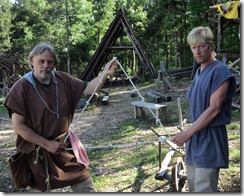 A bridge triangle or roof triangle (equilateral) appears with three sides of four spaces each (4-4-4). This triangle was used when a wider base than a “brace” was needed. Such as on bridges. This triangle also makes an excellent steep angle for roofs that won’t leak whether covered with tile in France, slate in Germany or thatch in England. Remember that in the Middle Ages they did not preorder roof trusses, but rather cut their own and therefore had attics. If you look at a picture even now of a city like Amsterdam you see steep roofs of this angle. The steep roofed carpenter’s hut at the Ozark Medieval Fortress uses this triangle and it is expected that it will be used on the castle tower roofs.
A bridge triangle or roof triangle (equilateral) appears with three sides of four spaces each (4-4-4). This triangle was used when a wider base than a “brace” was needed. Such as on bridges. This triangle also makes an excellent steep angle for roofs that won’t leak whether covered with tile in France, slate in Germany or thatch in England. Remember that in the Middle Ages they did not preorder roof trusses, but rather cut their own and therefore had attics. If you look at a picture even now of a city like Amsterdam you see steep roofs of this angle. The steep roofed carpenter’s hut at the Ozark Medieval Fortress uses this triangle and it is expected that it will be used on the castle tower roofs.
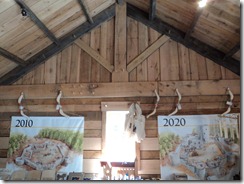 Modifying the triangle to ten spaces with four on the base and three on each side (3-4-3) gives the famous Egyptian pyramid triangle. This was used for roofs, bridge bracing and even the plumb bob level of the Middle Ages. This is the roof angle that has been used on the Visitor Center at the Ozark Medieval Fortress.
Modifying the triangle to ten spaces with four on the base and three on each side (3-4-3) gives the famous Egyptian pyramid triangle. This was used for roofs, bridge bracing and even the plumb bob level of the Middle Ages. This is the roof angle that has been used on the Visitor Center at the Ozark Medieval Fortress.

The laborers of the Middle Ages were primitive but skilled, industrious and clever. We often underestimate them.
Sunday, May 15, 2011
Medieval Stone: Quarry to Castle
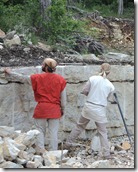 On tour at the Ozark Medieval Fortress many guests have asked about the quarry and if it is big enough to provide all the rocks for the castle and how the stone is quarried and carried to the castle site.
On tour at the Ozark Medieval Fortress many guests have asked about the quarry and if it is big enough to provide all the rocks for the castle and how the stone is quarried and carried to the castle site.
A first look at the wall of limestone at the quarry shows how beautiful the Arkansas grey-white stone looks. This is because 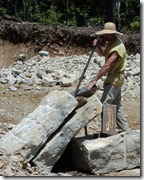 the limestone has magnesium and is actually called dolostone. It is a hard limestone that is perfect for the castle. It does mean a lot of extra work for the blacksmith to keep the chisels sharp and make the metal wedges for the quarrymen. A first look also makes the quarry seem small because the castle project is so big. It takes a lot of stone to build a castle, but using techniques from 1226, the rocks are not needed all at once and there is no worry about running out of rocks in the Ozarks.
the limestone has magnesium and is actually called dolostone. It is a hard limestone that is perfect for the castle. It does mean a lot of extra work for the blacksmith to keep the chisels sharp and make the metal wedges for the quarrymen. A first look also makes the quarry seem small because the castle project is so big. It takes a lot of stone to build a castle, but using techniques from 1226, the rocks are not needed all at once and there is no worry about running out of rocks in the Ozarks.
The committee of French Medieval historians who are the authenticators for the castle authorized in the beginning (in 2009) the use modern drills and explosives under United States specifications to open the quarry. That can be seen in the drill holes which are large 
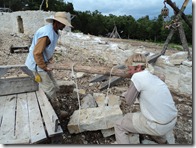 The large blocks of stone that were initially loosened from the cliff side were broken into slabs approximately one “span” (6-8”) thick. This was done by following the sedimentary lines of natural weakness in the stone. First, wedges were driven into the cracks and then metal rods were used to complete the break. Those slabs were then turned into usable and moveable stone for the castle wall. The largest were used for the first lintel stones over doors as well as the anchor stones in the wall. Large stones continue to be used as the anchor stones as well as the rough stones for the stone carvers to turn into specialty pieces around the doors and arrow loops. The slabs are also split into face stones for the castle using a French tool called a “chase masse”, a Medieval French stone cutting tool which looks like a hammer but is not. One side is placed against the rock and the other side is then struck with a hammer. This causes a series of shock waves to go through the rock and split it.
The large blocks of stone that were initially loosened from the cliff side were broken into slabs approximately one “span” (6-8”) thick. This was done by following the sedimentary lines of natural weakness in the stone. First, wedges were driven into the cracks and then metal rods were used to complete the break. Those slabs were then turned into usable and moveable stone for the castle wall. The largest were used for the first lintel stones over doors as well as the anchor stones in the wall. Large stones continue to be used as the anchor stones as well as the rough stones for the stone carvers to turn into specialty pieces around the doors and arrow loops. The slabs are also split into face stones for the castle using a French tool called a “chase masse”, a Medieval French stone cutting tool which looks like a hammer but is not. One side is placed against the rock and the other side is then struck with a hammer. This causes a series of shock waves to go through the rock and split it.
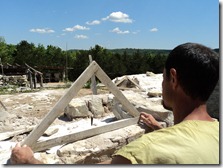 The rocks that are man-sized, which means the size one man can lift, are loaded into a large wheeled horse cart for transport to the castle. Larger stones are rolled onto a wooden sled and then dragged where needed by the horse and carter. All this takes teamwork between the quarrymen, masons, stone carvers, carter and, of course, the horse.
The rocks that are man-sized, which means the size one man can lift, are loaded into a large wheeled horse cart for transport to the castle. Larger stones are rolled onto a wooden sled and then dragged where needed by the horse and carter. All this takes teamwork between the quarrymen, masons, stone carvers, carter and, of course, the horse.
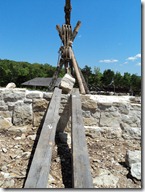 Once the stone is at the wall, the workers at the Ozark Medieval Fortress, like those of the Middle Ages, have the choice of using the Roman tread wheel crane to lift the stone or the use of ramps. Even though the crane is amazing and will be necessary in the future as the walls get taller, ramps are preferred by the men because if a rope breaks the consequences are much less if the big stone is on a ramp. The ramps are also much easier to move to where they are needed. The large stones are a lot of work to move and downright scary to fingers and toes, but make the castle stronger and are worth the extra effort and danger.
Once the stone is at the wall, the workers at the Ozark Medieval Fortress, like those of the Middle Ages, have the choice of using the Roman tread wheel crane to lift the stone or the use of ramps. Even though the crane is amazing and will be necessary in the future as the walls get taller, ramps are preferred by the men because if a rope breaks the consequences are much less if the big stone is on a ramp. The ramps are also much easier to move to where they are needed. The large stones are a lot of work to move and downright scary to fingers and toes, but make the castle stronger and are worth the extra effort and danger.
Once on the wall the various sized stones are arranged by 
Monday, May 2, 2011
Medieval Roof Tiles
Although the Ozark Medieval Fortress is in the process o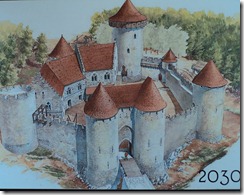 f building walls, many guests are intrigued by the prospect of the work necessary for the future roofs. Maybe this is because last year and this year have been rainy, but it may be because even a first look at the painting of the 2030 completed castle makes the roof seem like a daunting job. It is. This is not just because of the 12,000 tile that will have to be made by the potter, it is also because of the wooden framework the carpenters will have to build. That framework will be on top of the 45 to 70-foot high stone tower walls. It will be steep, dangerous and will require meticulous measurements to keep the rows of tile straight.
f building walls, many guests are intrigued by the prospect of the work necessary for the future roofs. Maybe this is because last year and this year have been rainy, but it may be because even a first look at the painting of the 2030 completed castle makes the roof seem like a daunting job. It is. This is not just because of the 12,000 tile that will have to be made by the potter, it is also because of the wooden framework the carpenters will have to build. That framework will be on top of the 45 to 70-foot high stone tower walls. It will be steep, dangerous and will require meticulous measurements to keep the rows of tile straight.
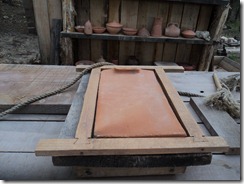 Fired clay roof tiles were well established as the standard castle roof in Medieval France. They go back to the ancient Greeks who used tile in an “S” shape. Clay tiles were expensive but fireproof, so a better choice than thatch. The Romans also used clay tile and the French word for tile, “tuile” came from the Latin “tegula” meaning roof tile. The Romans used an arched tile curved by the potters over their leg or a log.
Fired clay roof tiles were well established as the standard castle roof in Medieval France. They go back to the ancient Greeks who used tile in an “S” shape. Clay tiles were expensive but fireproof, so a better choice than thatch. The Romans also used clay tile and the French word for tile, “tuile” came from the Latin “tegula” meaning roof tile. The Romans used an arched tile curved by the potters over their leg or a log.
Clay tiles are heavy and, therefore, the stone walls of Greek temples, Roman buildings and Medieval castles were necessary for the strength needed to support them.
The Medieval French style of tile is flat, or 
Roofing companies still use authentic clay tiles and imitations because clay roof tiles create a quality, fireproof roof. They are not common, however, because of their cost. Still, it is good to remember that although the hand made tiles were a lot of work, they have lasted in the weather of Europe for hundreds of years.


